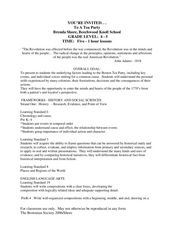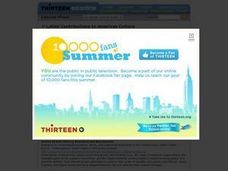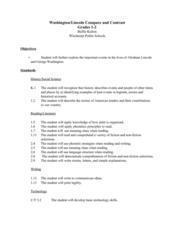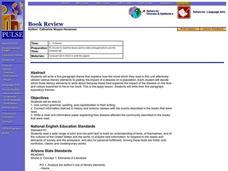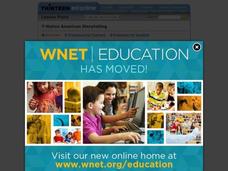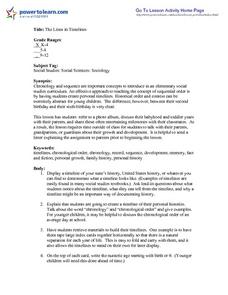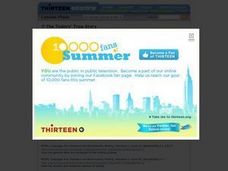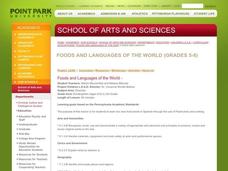Curated OER
Dr Who: Acronyms
Students explore abbreviations and acronyms. Students examine the difference between the two types. Students complete a worksheet, sorting words. They write a creative script containing abbreviations and acronyms.
Curated OER
Students Information And Interest Survey
In this personal information instructional activity, students fill out this form to give details about their personal history, prior experiences and preferences. This could be used for information gathering or as an icebreaker activity.
Curated OER
Proofreading Practice
In this proofreading practice online worksheet, 6th graders retype three passages correcting errors in spelling, punctuation, capitalization, grammar and usage, with answers available.
Curated OER
"The Fog Horn" by Ray Bradbury
Students read Ray Bradbury's "The Fog Horn" and complete reading and vocabulary activities. In this reading and vocabulary lesson plan, students review the vocabulary for the story and take turns reading the story. Students discuss the...
Curated OER
Steven Spielberg
In this famous person learning exercise, students read a passage about Steven Spielberg and then complete a variety of in-class and homework activities to support comprehension, including partner interviews, spelling, cloze, synonym...
Curated OER
Big Time Lessons
Teaching students about time can provide a way to talk about sundials, different types of clocks, and even time travel.
Curated OER
You're Invited...To A Tea Party
Kids read the book Boston Tea Party by Steven Kroll and use maps to locate various landmarks. They identify the cause and effect of the events related to the Boston Tea Party, then write a descriptive composition.
Curated OER
Treasure Chest
Young scholars explore Chicago in the fur-trading era. In this Chicago lesson, students discover what life what like during this time. Young scholars read an historical fiction story about life in the fur-trade era. Students view...
Curated OER
U.S. Post Office Mural Walking Tour
Students discover a sense of community by examining Post Office murals located in cities and small towns throughout the United States. They explore the significance of the murals by contacting and communicating with local Postmasters....
Curated OER
Latino Contributions To American Culture
Students create their own working definition of what it means to be an American. They examine the achievements of Latinos and discuss how the contribution of these Americans have enriched and helped shape American culture.
Curated OER
Washington/Lincoln Compare and Contrast
Young scholars examine the lives of George Washington and Abraham Lincoln. Using the information, they complete a Venn diagram discovering what the two men had in common. In groups, they review a timeline made in an earlier lesson and...
Curated OER
Language Arts Exploration
While an interesting lesson idea involving the exploration of a story about an Asian American boy named Imduk, a teacher would need to have assess to the Scott Foresman reading program to make this work. If not, a teacher could use...
Curated OER
Getting the Word Out: From Gutenberg's Press to Zines
High schoolers examine the effects of Gutenberg's printing press on the world. Using this information, they create their own Zines or internet magazines about a social issue of their choice. They share their magazine with the class for...
Curated OER
Book Review
Learners write a five paragraph theme that explains how the novel which they read in this unit effectively utilized various literary elements to portray the impact of a disease on a population. They then decide which three literary...
Curated OER
Native American Legends
Students work together in groups to research a Native American legend. They present the information they gathered in a format they chose. They write their own legend based on their research.
Curated OER
Digging Up Facts
Pupils research a historical legend. They participate in a discussion of the legend of Kissing Kate Barlow in the novel Holes. Students then chose one of three American legends and use internet research to complete a provided graphic...
Curated OER
The Lines in Timelines
Students are introduced to the concept of sequence by creating their own personal timeline. As a class, they put the events of the last week of their lives into the correct order and determine what information should be used for their...
Curated OER
The Numbers in Nonfiction
This library media PowerPoint introduces the system of nonfiction call numbers. Each slide includes information on what numbers go with each subject, along with colorful illustrations.
Curated OER
The Tudor's True Story
Students take effective notes from a video documentary, create an oral report about an assigned aspect of the video, and express an understanding of the King's six wives' lives.
Curated OER
Foods and Languages of the World
Students review Mexico's location and language and learn to pronouns 10 new Spanish food words. Students listen as the book, Corn is Maize is read, touching and passing around an ear of Indian corn. Students discuss the contribution of...
Curated OER
Would You Like to Become a Millionaire?
Students answer questions written by other teams about literature in an attempt to become "millionaires." In small groups they write a motivational introduction to their teams selected books, publish their questions as a HyperCard...
Curated OER
In Country: An Integrated Look at the Vietnam War
Students explore aspects of the Vietnam War and how it relates to the heritage of America. In an attempt to understand the level of involvement, students analyze statistics from the Vietnam war. Students watch a video, read a book, and...
Curated OER
Using Facebook with Literature
Young scholars use online social networking to learn about characters in literature. In this literature and technology lesson, students visit Facebook website and set up character profiles for a piece of literature they've read.
Curated OER
Transportation
Students explore basic transportation vehicles, specifically air, land, and water vehicles, name six different modes of transportation, identify four different kinds of train cars, and three differences between two different modes of...








